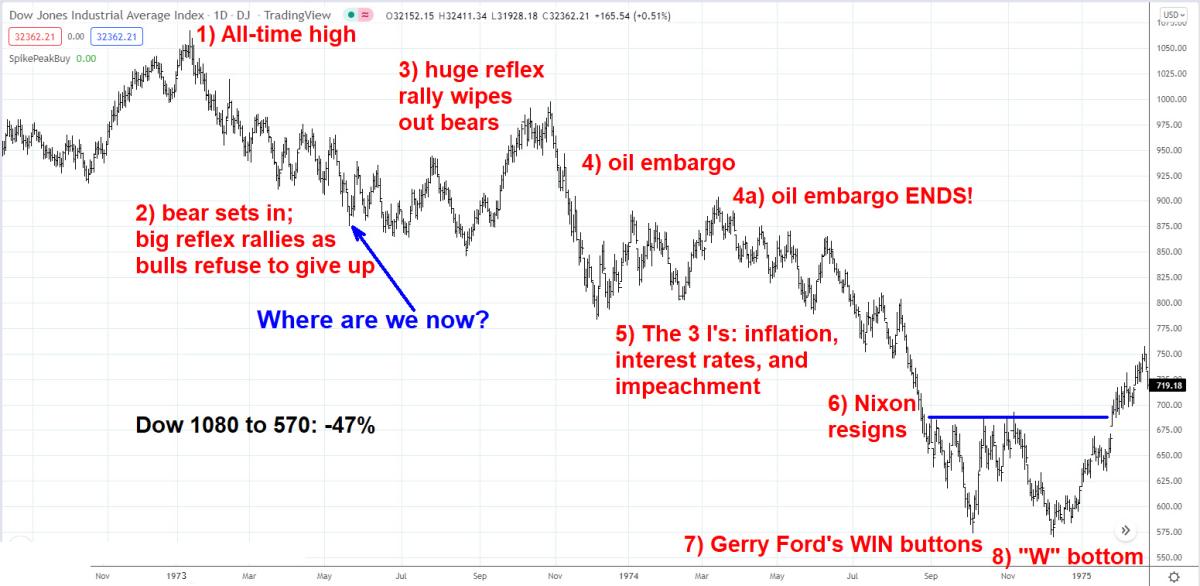

At the beginning of 1973, the Dow (no one paid much attention to $SPX back then) made a new all-time high, trading up to 1,067. The Barron’s Roundtable, a survey of top money managers and brokerage firm analysts, was published at the beginning of 1973 under the (now infamous) headline, “Not A Bear Among Them.” They were all bullish.
President Nixon declared that the Vietnam War was over (although it didn’t wind down completely until 1975). However, stocks had a mind of their own (then, and now), and the Dow began to immediately decline. That was the first market I traded seriously, and I was short.1 (Please refer to the chart of the Dow below while reading this article.)
The market immediately became quite volatile. There were no implied volatility measures at that time because the CBOE had not yet started trading (that would come a few months later, in April 1973). But realized volatility jumped from 10% to 23% over the first six months of 1973. The market was declining steadily and fairly rapidly over that period, but the countertrend rallies were large, too. By late June, the Dow was at 875. After a brief rally, it fell to 845 by late August. That was a decline of 20.9%.
But the bulls mounted a huge reflex rally, taking the Dow back to 997 by the end of October. This was the first time I heard the adage that “no one makes money in a bear market.” The point was that bulls refuse to sell and thus lose as their stocks plunged, but bears can’t withstand the huge countertrend rallies and eventually cover at losses. In this case, that was an 18% rally in just two months. There didn’t seem to be any specific reason for the rally (the Yom Kippur War occurred during that time, and Vice President Spiro Agnew resigned). But the oversold conditions had mounted enough to spur the rally, which then gained considerable momentum as the Dow raced higher.
However, trouble was brewing. The largest sign of trouble was the fact that OPEC was formed, and it imposed an oil embargo in mid-October 1973. At first, it didn’t have much effect on the stock market, but by the end of October, stocks began to decline sharply again, as gasoline prices rose sharply. Interest rates had been climbing since the end of World War II, so the fact that there was inflation wasn’t initially a cause for concern in 1973. But, with the rise in gasoline prices, inflation really took off and did become a cause for concern. Interest rates were rising along with inflation, too. By the end of 1973, T-bills were yielding 8%. Adding to the general series of problems was the fact that the Watergate hearings were gaining more ground, and there was a chance that President Nixon might be impeached. At the time, these problems were summarized as “The Three I’s”: inflation, interest rates, and impeachment.
The oil embargo, though, was what really drove the market down. The Dow fell from 897 to 783 by mid-December 1973, before a slight recovery into year-end. The bear market was back “on.” As 1974 began, the Dow rallied in a halting fashion, as the U.S. and other victims of the oil embargo negotiated an end to it. As rumors of the end of the embargo spread, the Dow rose to 900 by early March.
We didn’t have the sophisticated sentiment indicators back then that we have now. There was pretty much breadth and charts, and the charts were what garnered the most attention from technical analysts. A very rare formation occurred on the chart of the Dow—an “island reversal.” An island reversal is a gap up, followed relatively shortly (usually within a couple of weeks) by a gap down, with both gaps more or less at the same level. It is a bearish formation because all those who bought on or after the first gap—on whatever good news it was that spurred them on—suddenly realize they were trapped and begin to sell out what they bought (and more) after the second gap down. An island reversal on an index chart was almost unheard of in those days. The gaps are visible but not obvious in the accompanying chart of the Dow. They were much more obvious and visible if you were a chartist in March 1974.
The gap2 up occurred on March 5, as the Dow opened at 860 (after having closed at 853 the day before). It traded up to 880 before closing at 872 that day—a strong gain of 2.2%. The New York Times headline in the business section was “Dow index soars by 19.24 on oil hopes.” It’s hard to imagine that a 19-point gain was described as “soars,” but it was. The oil embargo officially ended on March 17, 1974. The Dow gapped down on March 28.
I distinctly remember being convinced from that gap down that the bears were back in charge. It was a Thursday. I went over the charts on Thursday night, selecting the stocks that I thought were the weakest. On Friday morning, I called my broker and shorted as much stock as I could in my account. There were no puts (you could create a synthetic put by shorting stock and buying a call, but calls were really expensive in 1974, so the resulting synthetic put was often too expensive to bother with). There were no indexes or ETFs; you just had to trade stocks. I remember shorting Sears near 90 and covering at 45 by the end of the year.
The Dow began to trade lower after that, as The Three I’s really began to weigh on the market. The Dow made new lows in July 1974, breaking below the 1973 lows. The countertrend rallies were still large, though, and made it tough to stay short. On Aug. 8, 1974, President Nixon resigned, and that set off a torrent of selling. The Dow dropped from 800 to nearly 650 in just one month. Then, after a modest attempt at a rally in September 1974, the Dow plunged to its lows at 573 on Oct. 4.
Then, one of the most ridiculous market catalysts of all time occurred. Gerald Ford was president, and he made a speech on Oct. 8, 1974, that literally said that inflation was “public enemy number one.” The speech was entitled “Whip Inflation Now.” While it entailed various economic measures, the thing I remember the most was the fact that the government issued WIN buttons. They were made readily available all across the U.S. They became a collector’s item. Well, damned if that didn’t break the back of the bear market. There was an immediate, explosive rally to 670 or so. The Dow didn’t break through right away, as it was repelled from that 670 level on several attempts.
Instead, there was a retest of the lows, which resulted in the Dow trading at 570 on Dec. 9, and that was the low, 46.6% down from the highs of January 1972. Realized volatility had reached 36% by then. The Dow traded higher after that, and on Jan. 27, 1975, gapped up strongly over that 670 resistance. The huge bear market was officially over at that point, but it had really died in October 1974, thanks to Gerry Ford and his WIN campaign! Ironically, the WIN campaign itself was considered a failure in its efforts to control inflation, but it marked the end of the bear market, as far as I’m concerned.
One story that left a lasting impression
Sometime early in 1974, maybe in the spring, I had a good trade in soybean oil. Soybean oil futures were worth $600 per point of movement, and I bought two contracts. They went up four points almost immediately, and I cashed out for a $4,800 gain. I bought the then-current Mustang with the profits. The new car came with a state-issued New Jersey license plate: 549 BUY.
I thought this was a sure sign that the market was going to 549, and then I would cover. At the time, the Dow was probably still above 800. The actual low was 570, not 549. So much for “the sign.” I was too literal about it and overstayed my welcome!
That whole bear market experience has influenced me throughout my trading lifetime: I am a much better bear market trader than a bull market trader.

Source: McMillan Analysis Corp.
Comparing the 1973–1974 bear to the 2022 market environment
Let’s address some similarities between then and now. In January 1972, the Dow made a new all-time high amid quite a bit of fanfare, but there had been negative divergences in place, as the “Nifty Fifty” stocks plowed ahead in 1972, but most other stocks did not. The same thing occurred in January 2022, only this time it was the “FAANG” stocks. The negative divergences for the broad market had been in place since mid-2021.
The ensuing decline during the first quarter of 1972 was fierce, with the market dropping 10% by mid-February and continuing down to that 20.9% loss in August. This year, $SPX lost 10% before the end of January and has already traded down 20.9% (the same amount!). So, perhaps this bear market is somewhat “speeded up” in terms of time comparisons to 1973–1974.
Interest rates and inflation are big factors again in 2022, as they were in 1972. Impeachment is not a factor in 2022, but things don’t always line up exactly.
As subscribers know, we trade the indicators as they occur, and we do not take long-term positions. That doesn’t prevent us from having long-term opinions, of course, and it seems to me that we are in a full-fledged, old-fashioned bear market that has quite a way to go. (Editor’s note: This article was first published on May 27, 2022.)
Currently, the short-term indicators have turned bullish. So we are probably in the midst of a tradeable oversold rally, which is not surprising. Rallies in bear markets look spectacular, but they eventually don’t hold. If this rally turns out to be of the magnitude of the one in October 1973, it would be devastating to the bears. If it is one of the smaller ones, that would be more normal.
If the road map of 1973–1974 continues to play out, where are we now? I would say we’re in about the same place as the market was in May 1973—still early. Or perhaps because things are speeded up now, and we have already reached that same -20.9% figure, we may currently be at a point that is more like July 1973. In any case, a large rally will ensue, but it won’t end the bear, which will continue until it exhausts itself.
1I had shorted the market, based on a combination of things. First, I had recently read “Technical Analysis of Stock Trends,” by Edwards and Magee. Second, I had subscribed to two newsletters—The Dines Letter and The Professional Tape Reader—both of which made compelling cases for shorting the market.
2Gaps in indexes were much harder to attain in those days. The way that the Dow was calculated back then was at the end of the day, the high price of each stock in the index was fed into the Dow pricing mechanism, and that was posted as the high of the day for the Dow. Of course, the Dow never really traded at that price, but that was what was posted. The same occurred for the low of the day. It wasn’t until many years later that the high and low were merely the actual high and low prices that the Dow traded at during the day.
The opinions expressed in this article are those of the author and do not necessarily represent the views of Proactive Advisor Magazine. These opinions are presented for educational purposes only.
This is an edited version of an article that was first published at optionstrategist.com on May 27, 2022.
New this week:
 Professional trader Lawrence G. McMillan is perhaps best known as the author of “Options as a Strategic Investment,” the best-selling work on stock and index options strategies, which has sold over 350,000 copies. An active trader of his own account, he also manages option-oriented accounts for clients. As president of McMillan Analysis Corporation, he edits and does research for the firm’s newsletter publications. optionstrategist.com
Professional trader Lawrence G. McMillan is perhaps best known as the author of “Options as a Strategic Investment,” the best-selling work on stock and index options strategies, which has sold over 350,000 copies. An active trader of his own account, he also manages option-oriented accounts for clients. As president of McMillan Analysis Corporation, he edits and does research for the firm’s newsletter publications. optionstrategist.com
